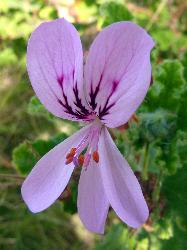- Taxon
- Gallery
- ≡ Geranium inodorum (Willd.) Poir., Encycl. 752 (1812)
- = Pelargonium clandestinum L'Hér. ex DC., Prodr. [A. P. de Candolle] 1, 660 (1824)
- = Pelargonium erodioides Hook., Journal of Botany 1: 252 (1834)
- = Pelargonium australe var. erodioides Benth., Fl. Austral. 1, 299 (1863)
- = Erodium peristeroides Turcz., Bull. Soc. Imp. Naturalistes Moscou 36: 592 (1863)
Annual or biennial hairy herb; stems sprawling, grooved, procumbent or spreading, sparingly branched. Petioles to 10–(30) cm long. Stipules small, ovate, ± scarious. Lamina (1)–1.5–5.5–(11) × (1)–1.7–5.5–(11) cm, broad-ovate or ± reniform, not lobed or with 3–5 shallow lobes, crenate or crenulate; base deeply and broadly cordate. Fls irregular, 5–15 in dense umbels; peduncles to c. 10 cm long, very slender; pedicels to c. 6 mm long. Sepals 2.5–5 mm long, ovate-oblong, mucronate or acute; calyx spur minute. Petals 3.5–6.5 mm long, usually pink or rose with purplish streaks on larger upper 2, occasionally white, spathulate, obovate, or oblanceolate. Mericarps 2–2.8 mm long; awn with long, patently pilose hairs. Seed black.
[From: Webb et al. (1988) Flora of New Zealand. Volume 4.]
Flowering: Dec.–Feb.




